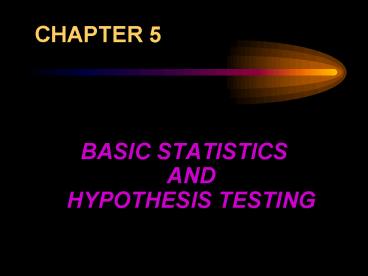BASIC STATISTICS AND HYPOTHESIS TESTING - PowerPoint PPT Presentation
1 / 26
Title:
BASIC STATISTICS AND HYPOTHESIS TESTING
Description:
The most important use of econometrics to ... Betas and using measures of dispersion like the standard error of the estimated ... t-Statistic = Beta/SE (Beta) ... – PowerPoint PPT presentation
Number of Views:958
Avg rating:3.0/5.0
Title: BASIC STATISTICS AND HYPOTHESIS TESTING
1
CHAPTER 5
- BASIC STATISTICSANDHYPOTHESIS TESTING
2
Introduction
- The most important use of econometrics to many
researchers is in testing their theories with
data from the real world. Therefore, we will
look at the t-test, the statistical tool
typically used for hypothesis tests of individual
regression coefficients, and the F-test of
overall significance.
3
3 Steps of Classical Hypothesis Testing
- 1. The development of hypotheses about the truth.
2. The calculation of estimates of the
coefficients and their standard errors.
3. The testing of the implications of the
estimates obtained in 2 for the hypotheses
stated in 1.
4
5.1 Statistical Inference
- Drawing conclusions about an entire population
based on a sample of data from that population.
Now we will see what our estimates mean so we can
infer something about the population from our
sample results.
5
- How do we decide whether the sample estimate of
Beta is close to the population Beta? Each
sample from the population gives us a different
estimate of Beta, resulting in the sampling
distribution of the estimated Betas discussed in
Chapter 4. As a result, its possible for an
estimate drawn from an unbiased distribution to
be quite far from the population coefficient.
6
- We can decide whether our estimate supports or
refutes our prior expectation by running
statistical tests on our estimated Betas and
using measures of dispersion like the standard
error of the estimated Beta to standardize the
comparisons. The main technique economists use
to achieve such inference is called hypothesis
testing.
7
5.2 What is Hypothesis Testing?
- Making inferences about the validity of specific
economic theories from a sample of the population
for which the theories are supposed to be true.
8
3 Topics that are Central to the Application of
Hypothesis Testing to Regression Analysis
1. The specification of the hypothesis to be
tested
- 2. The choice of a particular decision rule for
deciding whether to reject the hypothesis in
question
3. The kinds of errors that might be encountered
if the application of the decision rule to the
appropriate statistics yields an incorrect
inference
9
Classical Null and Alternative Hypotheses
- Null hypothesis a statement of the range of
values of the regression coefficient that would
be expected to occur if the researchers theory
were NOT correct (Ho B gt 0)
Alternative hypothesis used to specify the
range of values of the coefficient that would be
expected to occur if the researchers theory were
correct (Ha B lt 0)
10
Two-sided test (two-tailed test) when the
alternative hypothesis (Ha) has values on both
sides of the null hypothesis (Ho)(Ha B does
not 0)
One-sided test (one-tailed test) when the
alternative hypothesis (Ha) is only on one side
of the null hypothesis (Ho) (Ha B lt 0)
11
Type I and Type II Errors
- Type I Error when we reject a true null
hypothesis (Ho)
12
(No Transcript)
13
Type II Error when we do not reject a false
null hypothesis (Ho)
14
(No Transcript)
15
Decision Rules of Hypothesis Testing
- Decision Rule a hypothesis testing rule that
specifies in advance, for all possible values of
a test statistic that might be observed in a
sample, when the null hypothesis should be
accepted and when it should be rejected in favor
of the alternative hypothesis
Critical Value a value that divides the
acceptance region from the rejection region when
testing a null hypothesis
16
(No Transcript)
17
(No Transcript)
18
5.3 The t-Test
t-Statistic Beta/SE (Beta)
Critical t-Value the value of the t-statistic
that distinguishes the acceptance region from the
rejection region
t-Test Decision Rule reject the null hypothesis
(Ho) if the calculated t-value is greater in
absolute value than the critical t-value as long
as the sign of t is the same as the sign implied
in the alternative hypothesis (Ha)
19
Choosing a Level of Significance
Level of significance indicates the probability
of observing an estimated t-value greater than
the critical t-value if the null hypothesis (Ho)
were correct
20
Confidence Intervals
- Level of confidence (100 - level of
significance)
21
(No Transcript)
22
5.4 Example of One-Sided t-Test
23
4 Steps to Use When Working with the t-Test
- 1. Set up the null and alternative hypotheses
- Choose a level of significance and therefore
- a critical t-value
- Run the regression and obtain an estimated
- t-value (or t-score)
4. Apply the decision rule by comparing the
calculated t-value with the critical t-value in
order to reject or accept the Ho
24
5.5 Limitations of the t-Test
The t-Test Does Not Test Theoretical Validity
The t-Test Does Not Test Importance
The t-Test is Not Intended for Tests of the
Entire Population
25
5.6 The F-Test of Overall Significance
It tests the null hypothesis that the fit of the
equation isnt significantly better than that
provided by using the mean alone.
Ho B1 B2 B3 0 Ha Ho is not true F
ESS/K RSS/(nK1)
26
End of Chapter Exercises
1, 2, 13, 14, 15, and 16a, b, d, e































